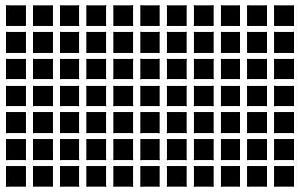Lateral inhibition facts for kids
In neurobiology, lateral inhibition is the ability of an excited neuron to reduce the activity of its neighbors. It stops action potentials from spreading in the lateral direction. It is called lateral inhibition as it stops (inhibits) neighboring neurons from firing. This creates a contrast in stimulation. This increases perception. For example, in vision, it helps in differentiating edges. It occurs primarily in visual processes. But it has also been seen in tactile, auditory, and even olfactory processing. Cells that use lateral inhibition are mainly present in cerebral cortex and thalamus. They make up lateral inhibitory networks (LINs). Artificial sensory systems have artificial lateral inhibition built in them. Examples are vision chips, hearing systems, and optical mice.
Images for kids
See also
 In Spanish: Inhibición lateral para niños
In Spanish: Inhibición lateral para niños




